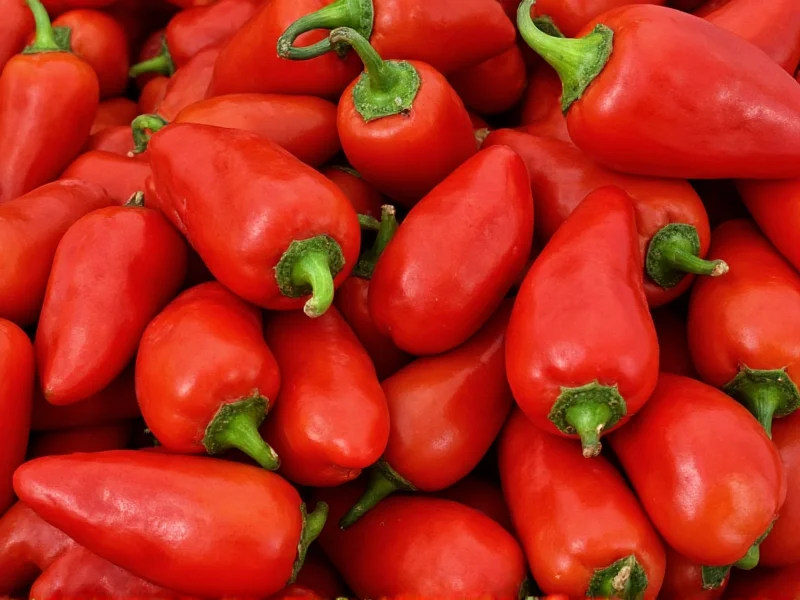When exploring are serrano peppers spicy, the answer is definitively yes. These slender, bright green peppers pack a notable punch that has made them staples in Mexican cooking for centuries. Understanding serrano pepper heat requires examining their position on the Scoville scale, factors affecting their spiciness, and how they compare to other common chili varieties.
Understanding Serrano Pepper Heat Level
Serrano peppers (Capsicum annuum) originate from the mountainous regions of Mexico, where their name derives from "sierra" or mountain range. Their heat level sits firmly in the medium-to-hot category of chili peppers. The Scoville scale, which measures capsaicin concentration, places serranos between 10,000-23,000 SHU. To put this in perspective, they're approximately two to five times hotter than standard jalapeños, which range from 2,500-8,000 SHU.
The heat in serrano peppers comes from capsaicinoids, primarily capsaicin, concentrated in the white pith and seeds. When evaluating how hot are serrano peppers compared to jalapeno, consider that even the mildest serrano exceeds the hottest jalapeño. This makes serranos a step up for those building heat tolerance or seeking more intense flavor in dishes.
Serrano Pepper Heat Comparison Chart
| Pepper Variety | Scoville Heat Units (SHU) | Relative Heat Level |
|---|---|---|
| Serrano Pepper | 10,000-23,000 | Moderate to Hot |
| Jalapeño Pepper | 2,500-8,000 | Mild to Moderate |
| Habanero Pepper | 100,000-350,000 | Very Hot |
| Thai Bird's Eye | 50,000-100,000 | Hot |
| Poblano Pepper | 1,000-2,000 | Mild |
Factors That Influence Serrano Pepper Spiciness
Several elements affect the actual heat level you'll experience when using serrano peppers:
- Growing conditions: Stressors like limited water or nutrient-poor soil increase capsaicin production, making peppers hotter
- Ripeness: Green serranos are typically milder than their red, orange, or yellow mature counterparts
- Part of the pepper: The placenta (white pith) contains the highest concentration of capsaicin, followed by seeds
- Individual variation: Even within the same plant, heat levels can vary significantly between peppers
When considering are green serrano peppers spicy, the answer remains yes—they're still notably hot, though generally milder than fully ripened red serranos. The green variety offers a grassier flavor profile while maintaining substantial heat.
Culinary Applications of Serrano Peppers
Chefs and home cooks value serranos for their bright, vegetal flavor that complements their heat. Unlike some hotter peppers that primarily deliver burn with minimal flavor, serranos provide complex taste notes. Common uses include:
- Pico de gallo and fresh salsas
- Adobos and marinades
- Infused vinegars and oils
- Garnishes for soups and stews
- Traditional Mexican dishes like chiles en nogada
When substituting serranos in recipes, remember that serrano pepper vs jalapeno heat differences mean you'll need fewer serranos to achieve similar heat levels. A general rule: use half as many serranos when replacing jalapeños in a recipe.
Safety Considerations When Handling Serrano Peppers
Due to their significant heat level, proper handling techniques are essential. The capsaicin in serranos can cause skin irritation and severe discomfort if it contacts eyes or mucous membranes. Follow these safety tips:
- Wear gloves when chopping serranos
- Avoid touching your face during preparation
- Wash hands thoroughly with soap after handling
- Remove seeds and white pith for milder heat
- Have dairy products (milk, yogurt) available to counteract heat if consumed
Understanding how to handle serrano peppers safely ensures you can enjoy their flavor without discomfort. If you accidentally touch your eyes after handling serranos, rinse with cold milk rather than water, as capsaicin is fat-soluble.
Why Serrano Peppers Deliver Their Distinct Heat
The distinctive heat profile of serranos comes from their specific capsaicinoid composition. While all hot peppers contain various capsaicin compounds, serranos have a particular balance that creates their characteristic sharp, immediate burn that dissipates relatively quickly compared to longer-lasting habanero heat.
When exploring why are serrano peppers so hot, consider their evolutionary purpose. The capsaicin deters mammals (who would crush seeds) while attracting birds (who disperse seeds intact). This biological adaptation explains why the heat feels so intense to humans.











 浙公网安备
33010002000092号
浙公网安备
33010002000092号 浙B2-20120091-4
浙B2-20120091-4